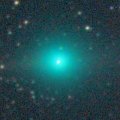
|
Now it is 5.4 mag (Feb. 16, Juan Jose Gonzalez). Also visible with naked eyes under the excellent sky condition. Now it is passing near by the earth, and moving westwards very rapidly. It keeps observable in the excellent condition long time around the highlight until spring. Because it moves along the ecliptic plane, the anti-tail is clearly visible.
Date(TT) R.A. (2000) Decl. Delta r Elong. m1 Best Time(A, h)
Feb. 14 13 54.61 -11 4.5 0.561 1.324 114 5.6 4:21 ( 0, 44)
Feb. 21 12 17.76 -1 34.7 0.429 1.370 147 5.2 2:19 ( 0, 53)
|
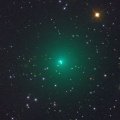
|
It has brightened much faster than expected. Now it is so bright as 8.6 mag (Feb. 13, Juan Jose Gonzalez). Very large and visible through binoculars. It keeps bright as 9 mag locating high in the evening sky, observable in good condition until February. Then it keeps observable for a long time until early summer.
Date(TT) R.A. (2000) Decl. Delta r Elong. m1 Best Time(A, h)
Feb. 14 4 56.85 16 51.9 0.788 1.454 109 9.3 19:20 ( 0, 72)
Feb. 21 5 16.12 17 9.6 0.832 1.467 107 9.6 19:12 ( 0, 72)
|
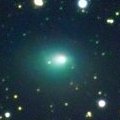
|
Brightening very rapidly, faster than expected. It is already so bright as 9.9 mag (Feb. 13, Juan Jose Gonzalez). It is expected to reach to 8 mag in 2009 summer. It becomes low tempporarily in February and March. But then it will be observable at 8-10 mag in good condition for a long time until late autumn.
Date(TT) R.A. (2000) Decl. Delta r Elong. m1 Best Time(A, h)
Feb. 14 22 22.09 36 27.9 3.964 3.416 50 9.8 19:06 (124, 16)
Feb. 21 22 26.17 35 43.2 3.996 3.390 46 9.8 19:12 (126, 11)
|

|
It brightened up to 9.8 mag in December and January (Dec. 28, Juan Jose Gonzalez). Now it is fading, but still bright as 10.9 mag (Feb. 13, Juan Jose Gonzalez). It keeps visible visually for a long time until June when it becomes low in the evening at 13 mag.
Date(TT) R.A. (2000) Decl. Delta r Elong. m1 Best Time(A, h)
Feb. 14 5 59.98 45 24.8 2.290 2.933 121 11.1 20:22 (180, 80)
Feb. 21 6 3.74 43 42.7 2.400 2.975 116 11.2 19:58 (180, 81)
|

|
It was expected to reach up to 7 mag and to be observable in good condition in winter. But finally, the comet has never been recovered after all. This comet has not been observed since 1986. It was not detected, fainter than 20 mag on Dec. 1 (Takaaki Oribe). So it will be much fainter than expected, maybe already disappeared.
Date(TT) R.A. (2000) Decl. Delta r Elong. m1 Best Time(A, h)
Feb. 14 2 56.71 21 58.7 1.139 1.412 82 11.3 19:06 ( 68, 64)
Feb. 21 3 25.29 23 30.5 1.219 1.467 82 12.1 19:12 ( 72, 63)
|
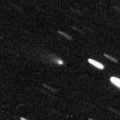
|
Brightening very rapidly, faster than expected. Now it is bright as 10.8 mag (Feb. 13, Juan Jose Gonzalez), already visible visually. It keeps 11 mag and observable in the evening sky for a long time until May.
Date(TT) R.A. (2000) Decl. Delta r Elong. m1 Best Time(A, h)
Feb. 14 0 51.22 5 27.8 1.671 1.259 48 11.7 19:06 ( 75, 29)
Feb. 21 1 13.91 8 25.1 1.675 1.250 47 11.5 19:12 ( 80, 29)
|
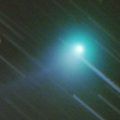
|
It reached to 6.3 mag in September in the southern sky (Sept. 4, Marco Goiato). It was bright at 10.0 mag still on Jan. 13 (U. Pilz). However, no visual observations have been reported since that. It keeps observable in the northern sky while fading gradually. In the Southern Hemisphere, it will never be observable again.
Date(TT) R.A. (2000) Decl. Delta r Elong. m1 Best Time(A, h)
Feb. 14 20 19.52 41 43.6 2.690 2.334 58 11.7 5:22 (237, 29)
Feb. 21 20 34.06 44 49.5 2.750 2.416 60 11.9 5:15 (234, 31)
|
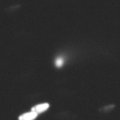
|
Already very bright as 11.7 mag (Feb. 1, Marco Goiato). It is expected to brighten up to 10 mag from late 2009 to early 2010. Good condition in the Southern Hemisphere. In the Northern Hemisphere, it is observable in the evening low sky from February to April. Then it becomes unobservable until September. But after October, it is observable at 10 mag for a while in good condition. In the Southern Hemisphere, it keeps observable for a long time while brightening until June when it brightens to 11 mag. But it becomes unobservable around and after the brightest time.
Date(TT) R.A. (2000) Decl. Delta r Elong. m1 Best Time(A, h)
Feb. 14 5 14.30 -43 54.8 3.187 3.425 95 12.2 19:36 ( 0, 11)
Feb. 21 5 15.14 -41 43.5 3.164 3.371 93 12.1 19:12 ( 1, 13)
|

|
Now it is 13.5 mag, already visible visually (Jan. 31, Alan Hale). It will be bright at 9-10 mag for a long time from spring to autumn.
Date(TT) R.A. (2000) Decl. Delta r Elong. m1 Best Time(A, h)
Feb. 14 17 8.91 -18 42.7 2.000 1.861 67 12.5 5:22 (325, 28)
Feb. 21 17 27.54 -18 59.6 1.909 1.827 70 12.2 5:15 (325, 28)
|
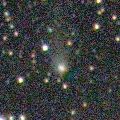
|
It brightened up to 11.5 mag in summer (Aug. 4, Marco Goiato). Although it is not observable in the Northern Hemisphere, it keeps observable in good condition for a long time in the Southern Hemisphere. However, no visual observations have been reported since last summer. Recent CCD observations suggest that it is still visible visually around 12-13 mag.
Date(TT) R.A. (2000) Decl. Delta r Elong. m1 Best Time(A, h)
Feb. 14 22 42.03 -75 47.2 3.116 2.810 63 12.5 19:06 ( 17,-34)
Feb. 21 23 42.42 -74 56.2 3.101 2.836 65 12.5 19:12 ( 18,-32)
|
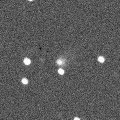
|
Now it brightened up to 12.4 mag (Feb. 13, Juan Jose Gonzalez). It will reach to 10-11 mag in June. In the Northern Hemisphere, it keeps observable in good condition until May when it becomes brightest. But it will never be observable again after that. In the Southern Hemisphere, it is not observable until April. But after that, it will be observable while fading gradually.
Date(TT) R.A. (2000) Decl. Delta r Elong. m1 Best Time(A, h)
Feb. 14 2 53.04 65 27.9 1.780 2.125 96 13.0 19:06 (160, 56)
Feb. 21 3 12.45 62 17.1 1.759 2.048 92 12.8 19:12 (154, 57)
|
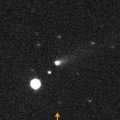
|
Now it is 14.3 mag (Jan. 8, Alan Hale), a bit fainter than expected, but already visible visually. It will to be observable at 12-13 mag for a long time from January to July.
Date(TT) R.A. (2000) Decl. Delta r Elong. m1 Best Time(A, h)
Feb. 14 9 41.71 19 17.4 1.443 2.427 173 13.0 0:07 ( 0, 74)
Feb. 21 9 35.79 19 38.1 1.434 2.407 166 12.9 23:29 ( 0, 75)
|
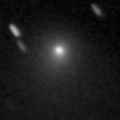
|
It reached to 10.9 mag in May (May 11, Marco Goiato). It is fading slowly. Now it is 13.9 mag (Feb. 14, Ken-ichi Kadota). It keeps bright as 13-14 mag for a long time after this until summer.
Date(TT) R.A. (2000) Decl. Delta r Elong. m1 Best Time(A, h)
Feb. 14 16 30.78 13 23.8 3.553 3.578 83 13.4 5:22 (310, 60)
Feb. 21 16 36.11 15 10.2 3.512 3.621 88 13.4 5:15 (314, 64)
|

|
Since the major outburst in last September, with a new outburst in December, it has been so bright as 10-11 mag for about half a year. Now it is still bright as 11.4 mag (Feb. 14, Carlos Labordena).
Date(TT) R.A. (2000) Decl. Delta r Elong. m1 Best Time(A, h)
Feb. 14 7 47.67 23 44.0 5.236 6.105 149 13.5 22:09 ( 0, 79)
Feb. 21 7 45.09 23 43.5 5.302 6.107 141 13.5 21:39 ( 0, 79)
|
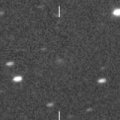
|
It must have been fainter than 18 mag, however, an outburst occured unexpectedly on Jan. 30 and it brightened up to 15.2 mag (Catalina Sky Survey). Then it is fading rapidly. It has already faded down to 17.2 mag (Feb. 14, Yasukazu Ikari).
Date(TT) R.A. (2000) Decl. Delta r Elong. m1 Best Time(A, h)
Feb. 14 11 36.05 40 10.0 1.820 2.685 144 17.0 2:01 (180, 85)
Feb. 21 11 30.10 40 53.0 1.839 2.714 145 17.9 1:27 (180, 84)
|
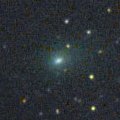
|
First return of a bright new periodic comet discovered by SOHO spacecraft in 2003. Now it was re-discovered by STEREO-B spacecraft. It reached up to 6-7 mag in the SOHO images in late December, then it was observed around 10 mag in the morning sky in early January. Now it is fading. But it is still bright as 12.5 mag (Feb. 5, Michael Jager). It keeps observable in good condition while fading gradually after this.
Date(TT) R.A. (2000) Decl. Delta r Elong. m1 Best Time(A, h)
Feb. 14 16 2.83 -3 29.6 0.723 1.184 86 14.4 5:22 (335, 49)
Feb. 21 15 56.99 -2 9.9 0.740 1.282 94 15.0 5:15 (344, 52)
|
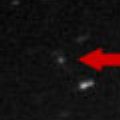
|
It had been observed until mid January in the evening low sky. It reached up to 14.1 mag (Jan. 11, Ken-ichi Kadota). Now it is not observable. It will be observable again in summer, but it will be fainter than 17 mag.
Date(TT) R.A. (2000) Decl. Delta r Elong. m1 Best Time(A, h)
Feb. 14 22 29.96 -7 40.1 2.735 1.777 11 14.7 19:06 ( 86, -7)
Feb. 21 22 48.82 -6 16.6 2.759 1.788 8 14.7 19:12 ( 89, -9)
|

|
Now it is 13.9 mag (Feb. 7, Ken-ichi Kadota). It had been bright and visible visually around 13 mag from spring to autumn in 2008. It will be visible visually at 14 mag again until summer.
Date(TT) R.A. (2000) Decl. Delta r Elong. m1 Best Time(A, h)
Feb. 14 15 12.88 27 8.0 5.960 6.275 104 14.7 5:22 (337, 81)
Feb. 21 15 9.69 28 19.8 5.892 6.297 109 14.7 5:06 ( 0, 83)
|
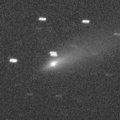
|
It reached up to 9.6 mag in summer (Aug. 2, Juan Jose Gonzalez). Now it is fading. It has already faded down to 14.0 mag (Feb. 1, Ken-ichi Kadota). It keeps observable and fading in the morning sky after this. It will be visible visually for some more time.
Date(TT) R.A. (2000) Decl. Delta r Elong. m1 Best Time(A, h)
Feb. 14 13 52.34 35 13.3 1.856 2.516 121 14.8 4:16 (180, 90)
Feb. 21 13 49.25 36 30.6 1.858 2.566 125 14.9 3:46 (180, 89)
|
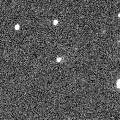
|
Now it is 15.3 mag (Feb. 2, Ken-ichi Kadota). It will brighten up to 12-13 mag in 2010 summer. It reaches to 14.5 mag in 2009 spring, and keeps observable in good condition until 2009 summer.
Date(TT) R.A. (2000) Decl. Delta r Elong. m1 Best Time(A, h)
Feb. 14 12 40.20 10 14.3 2.442 3.247 138 14.9 3:05 ( 0, 65)
Feb. 21 12 38.15 10 46.6 2.362 3.226 145 14.8 2:35 ( 0, 66)
|
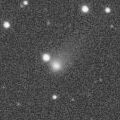
|
It brightened up to 12.7 mag in 2008 spring (Apr. 12, Marco Goiato). But it faded down to 14.9 mag in July (July 22, Mitsunori Tsumura). No observations have been reported for a long time since last summer. But in the Southern Hemisphere, it has appeared in the morning sky, and it will be observable in good condition after this. It will never be observable again in the Northern Hemisphere.
Date(TT) R.A. (2000) Decl. Delta r Elong. m1 Best Time(A, h)
Feb. 14 18 31.29 -45 26.1 3.950 3.446 52 15.1 5:22 (326, -4)
Feb. 21 18 44.16 -45 56.2 3.915 3.480 57 15.1 5:15 (327, -3)
|

|
Now it is 15.5 mag (Feb. 14, Catalina Sky Survey). It will be observable at 15-16 mag in good condition until spring.
Date(TT) R.A. (2000) Decl. Delta r Elong. m1 Best Time(A, h)
Feb. 14 9 22.42 23 46.9 2.634 3.604 167 15.2 23:43 ( 0, 79)
Feb. 21 9 17.78 24 8.3 2.653 3.600 160 15.2 23:11 ( 0, 79)
|

|
Now it is 15.7 mag (Feb. 1, Ken-ichi Kadota). It will be observable at 15 mag in good condition in spring.
Date(TT) R.A. (2000) Decl. Delta r Elong. m1 Best Time(A, h)
Feb. 14 12 40.56 13 56.0 1.672 2.500 138 15.6 3:05 ( 0, 69)
Feb. 21 12 37.03 13 43.3 1.602 2.483 145 15.4 2:34 ( 0, 69)
|

|
Now it is 16.2 mag (Jan. 3, Ken-ichi Kadota). It should have reached up to 14.5 mag in summer in the southern sky, but it is already fading. It keeps observable while the comet will be fading slowly after this.
Date(TT) R.A. (2000) Decl. Delta r Elong. m1 Best Time(A, h)
Feb. 14 12 5.93 -21 30.7 2.908 3.643 131 16.0 2:31 ( 0, 33)
Feb. 21 12 0.27 -19 47.3 2.877 3.693 140 16.1 1:57 ( 0, 35)
|
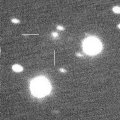
|
Now it is 16.4 mag (Jan. 1, Ken-ichi Kadota). It will be getting fainter and lower in the evening sky. It becomes unobservable in May.
Date(TT) R.A. (2000) Decl. Delta r Elong. m1 Best Time(A, h)
Feb. 14 2 55.67 25 32.2 2.256 2.361 83 16.2 19:06 ( 75, 65)
Feb. 21 3 7.13 25 47.1 2.333 2.358 79 16.3 19:12 ( 81, 61)
|
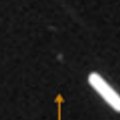
|
Now it is 16.9 mag (Jan. 22, P. C. Sherrod). It will brighten rapidly and will be observable at 16.5 mag from February to April. It moves southwards very fast after early April, and will be unobservable very soon in the Northern Hemisphere.
Date(TT) R.A. (2000) Decl. Delta r Elong. m1 Best Time(A, h)
Feb. 14 12 59.16 68 37.3 0.455 1.260 116 16.5 3:22 (180, 57)
Feb. 21 14 3.32 72 7.7 0.418 1.198 110 16.4 3:57 (180, 53)
|
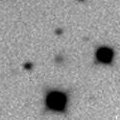
|
At the discovery in 2001, it became much brighter after the perihelion passage. In this apparition, although it was so faint as 20 mag in early September, it brightened very rapidly, and it reached up to 16.3 mag (Feb. 5, Ken-ichi Kadota). It keeps observable in good condition for a while after this. But it will fade out rapidly after this. It has already faded down to 16.9 mag (Feb. 11, Ken-ichi Kadota). It will be fainter than 18 mag in April.
Date(TT) R.A. (2000) Decl. Delta r Elong. m1 Best Time(A, h)
Feb. 14 8 18.47 24 43.5 1.079 2.020 155 16.9 22:40 ( 0, 80)
Feb. 21 8 17.15 25 9.4 1.129 2.037 148 17.0 22:11 ( 0, 80)
|
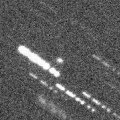
|
Now it is 17.0 mag (Jan. 12, Ken-ichi Kadota). It will be observable at 16.5 mag in good condition in 2009 spring.
Date(TT) R.A. (2000) Decl. Delta r Elong. m1 Best Time(A, h)
Feb. 14 17 34.06 25 19.6 3.126 2.994 73 16.9 5:22 (275, 55)
Feb. 21 17 30.61 26 24.0 3.037 3.006 78 16.9 5:15 (278, 60)
|

|
Brightening rapidly than expected. It reached up to 17.2 mag (Jan. 20, Yasukazu Ikari). It will keep 17 mag until February, and will be observable in good condition until April when it becomes fainter than 18 mag.
Date(TT) R.A. (2000) Decl. Delta r Elong. m1 Best Time(A, h)
Feb. 14 10 2.65 13 30.9 0.667 1.654 176 17.0 0:28 ( 0, 69)
Feb. 21 9 58.53 12 33.0 0.677 1.664 175 17.0 23:52 ( 0, 67)
|

|
Peculiar asteroid moving along a cometary orbit. It will be observable around 17 mag in good condition for a long time until May. It will fade out very rapidly after May.
Date(TT) R.A. (2000) Decl. Delta r Elong. m1 Best Time(A, h)
Feb. 14 14 35.60 -4 13.7 1.269 1.823 107 17.3 5:00 ( 0, 51)
Feb. 21 14 39.71 -4 23.4 1.242 1.866 113 17.2 4:36 ( 0, 51)
|

|
It keeps observable at 17.5 mag until spring. But it locates low in the Northern Hemispere.
Date(TT) R.A. (2000) Decl. Delta r Elong. m1 Best Time(A, h)
Feb. 14 8 25.80 -24 37.7 3.664 4.438 137 17.3 22:47 ( 0, 30)
Feb. 21 8 22.01 -24 29.1 3.685 4.440 134 17.3 22:15 ( 0, 31)
|

|
Now it is 17.6 mag (Jan. 24, Ken-ichi Kadota). It will reach to 15 mag in 2010. It keeps observable for a long time after this in the Northern Hemisphere.
Date(TT) R.A. (2000) Decl. Delta r Elong. m1 Best Time(A, h)
Feb. 14 15 38.47 -6 54.2 6.368 6.466 91 17.6 5:22 (345, 47)
Feb. 21 15 40.04 -6 18.1 6.218 6.430 97 17.6 5:15 (352, 48)
|

|
It will reach to 17 mag at opposition in March. But then it will fade out soon, and will be fainter than 18 mag in May.
Date(TT) R.A. (2000) Decl. Delta r Elong. m1 Best Time(A, h)
Feb. 14 12 17.51 -8 54.4 1.852 2.664 137 17.9 2:42 ( 0, 46)
Feb. 21 12 16.37 -8 56.8 1.782 2.650 144 17.7 2:13 ( 0, 46)
|
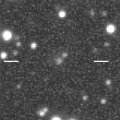
|
Now it is 17.6 mag (Jan. 10, Ken-ichi Kadota). It keeps observable in good condition at 17.5-18 mag until March.
Date(TT) R.A. (2000) Decl. Delta r Elong. m1 Best Time(A, h)
Feb. 14 4 56.09 14 5.1 1.916 2.422 108 17.8 19:18 ( 0, 69)
Feb. 21 5 0.39 15 19.7 1.989 2.413 103 17.8 19:12 ( 12, 70)
|
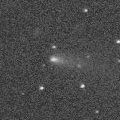
|
It reached up to 13.7 mag and became visible visually (Nov. 6, Juan Jose Gonzalez). However, it is already fading. It has faded down to 17.0 mag (Jan. 14, Ken-ichi Kadota). It will be fainter than 18 mag in February.
Date(TT) R.A. (2000) Decl. Delta r Elong. m1 Best Time(A, h)
Feb. 14 3 43.99 13 0.4 2.195 2.429 91 17.8 19:06 ( 35, 64)
Feb. 21 3 52.82 13 46.5 2.304 2.454 86 18.0 19:12 ( 47, 62)
|
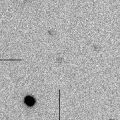
|
It was observed at 18 mag from autumn to winter in 2007. It will be observable again at 18 mag from winter to spring in 2009.
Date(TT) R.A. (2000) Decl. Delta r Elong. m1 Best Time(A, h)
Feb. 14 10 34.67 -6 16.1 4.694 5.620 157 17.9 1:00 ( 0, 49)
Feb. 21 10 31.72 -6 13.6 4.674 5.626 162 17.9 0:29 ( 0, 49)
|
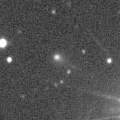
|
It was observed as bright as 14-15 mag in 2007 autumn. Now it is 18.2 mag (Jan. 24, Ken-ichi Kadota). It keeps observable in good condition for a while. It will be fainter than 18 mag in Feburary.
Date(TT) R.A. (2000) Decl. Delta r Elong. m1 Best Time(A, h)
Feb. 14 7 34.04 33 44.4 2.855 3.691 142 17.9 21:55 ( 0, 89)
Feb. 21 7 30.94 33 26.6 2.945 3.717 135 17.9 21:25 ( 0, 88)
|

|
Great outburst occured in 2007 October, and it bacame a naked eye comet of 2 mag. It kept so bright as 5.5 mag still in 2008 spring (Apr. 30, Carlos Labordena), but it was extremely faint and difficult to see. The size was so large, the diameter was larger than 60 arcmin. Now it became observable in good condition again. The extremely faint large diffuse glow may be detected with a best sky condition, around 5-6 mag with a diameter of 1 or 2 degrees. Mitsunori Tsumura detected a possible glow of Comet Holmes on Nov. 4. Current brightness of the central core is 17.7 mag (Feb. 13, Catalina Sky Survey), much brighter than pre-outburst brightness still now.
Date(TT) R.A. (2000) Decl. Delta r Elong. m1 Best Time(A, h)
Feb. 14 8 33.90 26 47.7 3.367 4.296 157 18.8 22:55 ( 0, 82)
Feb. 21 8 28.88 26 42.2 3.433 4.317 149 18.9 22:22 ( 0, 82)
|
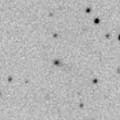
|
It was observed bright at 16.5-17 mag from late 2006 to early 2007. However, it is fading after that, although it is getting closer to the sun. It was so faint as 19.4 mag around the perihelion passage in 2008 spring (Mar. 10, Mitsunori Tsumura). This comet was observed so faint around the perihelion passage in the previous apparition at the discovery. It faded out before the perihelion passage again in this apparition. No observations have been reported since 2008 April at all.
Date(TT) R.A. (2000) Decl. Delta r Elong. m1 Best Time(A, h)
Feb. 14 11 49.14 21 32.8 3.482 4.368 150 21.6 2:14 ( 0, 76)
Feb. 21 11 46.36 22 12.0 3.455 4.376 155 21.6 1:43 ( 0, 77)
|
|
![]()
 67P/Churyumov-Gerasimenko
67P/Churyumov-Gerasimenko C/2008 A1 ( McNaught )
C/2008 A1 ( McNaught ) C/2007 Q3 ( Siding Spring )
C/2007 Q3 ( Siding Spring ) 22P/Kopff
22P/Kopff C/2007 G1 ( LINEAR )
C/2007 G1 ( LINEAR ) C/2008 T2 ( Cardinal )
C/2008 T2 ( Cardinal ) 116P/Wild 4
116P/Wild 4 C/2006 Q1 ( McNaught )
C/2006 Q1 ( McNaught ) 29P/Schwassmann-Wachmann 1
29P/Schwassmann-Wachmann 1 33P/Daniel
33P/Daniel 210P/2008 X4 ( Christensen )
210P/2008 X4 ( Christensen ) 68P/Klemola
68P/Klemola C/2005 L3 ( McNaught )
C/2005 L3 ( McNaught ) 19P/Borrelly
19P/Borrelly 65P/Gunn
65P/Gunn C/2007 B2 ( Skiff )
C/2007 B2 ( Skiff ) 74P/Smirnova-Chernykh
74P/Smirnova-Chernykh 77P/Longmore
77P/Longmore C/2006 U6 ( Spacewatch )
C/2006 U6 ( Spacewatch ) 59P/Kearns-Kwee
59P/Kearns-Kwee 209P/2008 X2 ( LINEAR )
209P/2008 X2 ( LINEAR ) 204P/2008 R5 ( LINEAR-NEAT )
204P/2008 R5 ( LINEAR-NEAT ) C/2008 Q1 ( Maticic )
C/2008 Q1 ( Maticic ) P/2008 Y2 ( Gibbs )
P/2008 Y2 ( Gibbs ) 2001 TX16
2001 TX16 P/2008 Y3 ( McNaught )
P/2008 Y3 ( McNaught ) C/2008 FK75 ( Lemmon-Siding Spring )
C/2008 FK75 ( Lemmon-Siding Spring ) 143P/Kowal-Mrkos
143P/Kowal-Mrkos 211P/2008 X1 ( Hill )
211P/2008 X1 ( Hill ) 61P/Shajn-Schaldach
61P/Shajn-Schaldach C/2007 S2 ( Lemmon )
C/2007 S2 ( Lemmon ) 188P/2007 J7 ( LINEAR-Mueller )
188P/2007 J7 ( LINEAR-Mueller ) 17P/Holmes
17P/Holmes 173P/2005 T1 ( Mueller 5 )
173P/2005 T1 ( Mueller 5 )![]()






























